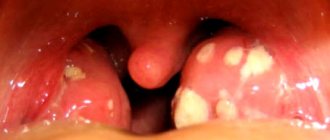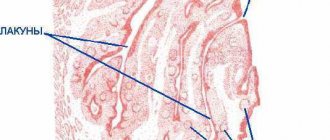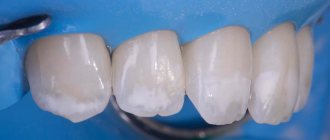July 27, 2018
Pus on the tonsils is a bad sign, which indicates the presence of an infection in the body caused by the proliferation of pathogenic bacteria: streptococci and staphylococci. As is known, the process of their formation is strictly controlled by immune forces, and with a general weakening of the immune system, diseases of the nasopharynx, caries, inflammation of the gums, or simply hypothermia, microorganisms break through all possible barriers and affect the surrounding areas with tremendous speed, which leads to general intoxication.
The editors of the UltraSmile.ru portal believe that anyone can face such a problem as ulcers on the tonsils. It is for this purpose that we will try to explain to you the mechanism of the appearance of this unpleasant phenomenon and identify the main types of diseases that tend to manifest themselves in this way. At the end of the material, be sure to look for information on how you can be cured.
Pus on the tonsils is a bad sign
What are tonsils and what function do they perform?
Tonsils (aka tonsils) are the focus of lymphatic tissue, which serves as a kind of barrier to protect against harmful bacteria and block their penetration into the body. They are located in the oral cavity, namely in the pharynx. There are only six of them in total, but they are different, which is why people often have confusion regarding their name and definition: tonsils (located behind the palate), tubal, pharyngeal and lingual tonsils - the last four are actually not visible to us.
If you open your mouth, you will see that its internal tissues are connected into a kind of ring, which is called lymphoid. This is a barrier. With good immune forces of the body and with general health of the oral cavity, when the balance of microflora in it is not disturbed and a person does not have dental problems such as caries, it is a serious obstacle to microorganisms; in case of bad ones, the tissues themselves first take the blow, resulting in the appearance of purulent tonsils. This is a signal that you need to act immediately.
Abscesses in the tonsils can be completely different: both single and multiple, large and small, yellow and white. They can be localized on the visible surface or “hide” in the folds of lymphoid tissue. It all depends on the individual anatomical characteristics of the person and the nature of the disease. One thing can be said - the photo clearly shows that such formations can give a person a lot of unpleasant sensations, ranging from pain and discomfort, refusal to eat, putrid breath, ending with a deterioration in general health.
This is what ulcers on the tonsils look like
Please note that ulcers on the tonsils and tonsils in a child or an adult are rarely a separate disease. This is always a consequence of weakened immunity, the presence of a constant source of infection in the mouth (destroyed and diseased teeth affected by caries, pulpitis, periodontitis) and other serious diseases. We list the main ones in order.
White ulcers on the tonsils: treatment
To get rid of purulent plaque, it is not enough to treat the throat only with local medications. Therapy must be comprehensive and affect the entire body, which directs all its forces to fight the infection.
It is necessary to help him with this, since ulcers in the throat are not a separate disease, but a symptom of some disease.
Therefore, in order to cure a patient, an accurate diagnosis must be made, since each pathology corresponds to a specific treatment.
How to treat a throat with ulcers on the tonsils?
The most effective means are medications:
1
Antibacterial therapy. A sore throat with ulcers on the tonsils necessarily requires a course of antibiotic therapy. The doctor decides which antibiotics to take based on the clinical picture and the nature of the purulent plaque.
Preference is given to penicillin antibiotics, cephalosporins, and macrolides. They have a bactericidal effect on most pathogens that cause upper respiratory tract infections.
2
Antihistamines are used in conjunction with antibiotics to reduce the risk of an allergic reaction to them. In addition, antihistamines relieve swelling and irritation of soft tissues.
3
Non-steroidal anti-inflammatory drugs. Used to reduce elevated body temperature. In addition, they have anti-inflammatory and analgesic effects, so their use is permissible in cases of severe pain, especially in children.
4
Topical treatment includes medications that act directly on the throat. Available in the form of tablets, lozenges, lozenges, various sprays and rinsing solutions.
For children, medications are prescribed according to age dosage.
How to gargle:
1
Pharmaceutical medicines. Available in liquid or dry form, which must be diluted with water.
2
Furacilin solution has a bacteriostatic and anti-inflammatory effect. Gargle your throat several times a day after meals.
3
Saline solution. The most common method among the population. Prepared by adding a tablespoon to a glass of water. There are no restrictions on the number of times it can be used. Relieves swelling of soft tissues, thereby providing an anti-inflammatory and softening effect.
4
Soda solution is an equally well-known gargle. To prepare such a solution, add a teaspoon of baking soda to a glass of warm water. From a medical point of view, this remedy is especially effective against fungal plaque in the mouth.
5
Decoctions, infusions, tinctures of herbs that have antiseptic and anti-inflammatory effects. They also reduce irritation and pain. These are well-known antiseptics of plant origin: chamomile flowers, calendula, sage, oak bark, coltsfoot.
[ads-pc-1][ads-mob-1] to content ?
Purulent sore throat
White, brown or yellowish pustules on the tonsils are characteristic of several types of acute ENT diseases:
- follicular: here, among other things, the patient’s mucous membrane swells, the tonsils change their shade from pink to painful red. The pustules themselves on the tonsils periodically open up and swell again,
- lacunar: lacunae are small depressions on the surface of the lymphatic tissue; in this case, they are filled with purulent exudate. In the absence of therapeutic measures, all tonsils become covered with a yellow coating. True, this continuous layer is quite easily and simply removed with a brush, but it also easily and simply grows again.
Important!
Some, having discovered pus on their tonsils, try to prescribe treatment on their own, having previously scoured the Internet.
They use piercing the follicles with needles, warming the throat and squeezing out the contents with cotton swabs and hydrogen peroxide, treating the affected areas with vinegar or even kerosene. We warn you - this is extremely dangerous, traumatic and can make the situation even worse. You can burn your entire mucous membrane, get a secondary infection and open wound surfaces that will hurt and heal for a very long time. In addition to the symptoms listed above, a person with a purulent sore throat suffers from an increase in body temperature of up to 40 degrees and chills, headaches and sharp pain when swallowing and when chewing food - if an abscess on the tonsil is found in a child, then he will generally refuse to eat, scream and be capricious , express anxiety in your sleep and cry often.
Signs of purulent sore throat are difficult to miss
How to remove pus from tonsils yourself at home
Extracted purulent plugs
If you can’t see a doctor or if purulent plugs are a common problem, you can remove the pus yourself. In the initial stages, superficial pustules can be removed by rinsing the mouth with special decoctions and infusions, which are either sold in pharmacies or can be made independently. Procedure:
- Wash your hands , treat the instruments that will be used in the process of removing purulent plugs with an antiseptic or regular alcohol.
- Prepare a mirror , spoon, bandage and antiseptic.
- To remove pus, you will need a medical spatula, but not every first aid kit has such a tool, so you can use an ordinary clean pencil or a plastic stick.
- Wrap a bandage pre-moistened in antiseptic on a prepared medical spatula or its alternative.
- If there is no medical antiseptic in the first aid kit, you can use honey and salt.
- The spoon is needed to press the tongue. It should not interfere during the procedure.
- Use a spatula to gently press on the purulent formations. If the pus does not begin to stand out, you should simply remove it with a bandage from the surface of the tonsils. The main thing is to act carefully and squeeze out the pus without damaging the mucous membrane.
- After all purulent formations have been removed, after squeezing, you need to gargle hourly to protect open wounds from harmful microbes.
Chronic tonsillitis
You will be interested to know that the nature of this disease can not only be infectious, but also has an allergic etiology. In this case, the tonsils not only can no longer fight the autoimmune inflammatory process, but they themselves become a source of infection, against which the body constantly enters into confrontation. As a result, frequent diseases occur; white pustules appear on the tonsils with unenviable frequency. This also contributes to pathological changes in the structure of lymphatic tissue.
“In general, pus in my tonsils was a consequence of sinusitis. As the ENT specialist later said, both rhinitis and pharyngitis could have contributed to such an unpleasant phenomenon, since despite the fact that the nose is susceptible to these diseases, the pharynx is inextricably linked with it, where some bacteria can easily penetrate. Fortunately, everything worked out without severe complications and even without fever, since treatment was prescribed on time.”
NataT, review on the otzovik.com forum
During the disease, a person’s body temperature remains within 37.5 degrees, but can remain there for a very long time. Plus, stale, putrid “amber” from the mouth is added. The patient always feels like there is something in his throat and he even begins to feel foreign tastes, regardless of the time of meals. There are no pronounced pains, only a feeling of discomfort.
Respiratory diphtheria
This is a serious infection, which, in addition to the formation of large gray or white ulcers on the throat and swollen tonsils, as in the photo, is characterized by fever, inflammation of the lymph nodes, difficulty not only in eating and swallowing, but even in breathing.
This is what respiratory diphtheria looks like
It may be helpful for you to know that the best way to prevent diphtheria is through vaccination,1 which was first invented in the 1920s. This is what has made it possible to sharply reduce the number of children and adults with this disease. To this day, the vaccine is given at the age of 2.4 and 6 months (if there are no contraindications), then it is recommended to repeat it at the age of 18 months and when the child reaches 6 years. Further, after 16 years, it can be repeated every 10 years of life. Today, vaccines of this type make it possible to stop several infectious agents at once: diphtheria, whooping cough, tetanus.
What do you think about mandatory vaccinations? Do you think that they should be done for children or will all this only bring harm? We are waiting for answers in the comments>>>
Scarlet fever in children
Pus on a child’s tonsils very often occurs as a result of scarlet fever; it is not for nothing that it is also commonly called a “childhood disease.” It mainly affects children under 10 years of age. In adults who are over 30 years old, the chances of getting sick generally tend to zero. The disease is often registered in the autumn-winter period, associated with a lack of sun, vitamins in the diet, increased concentration of children in closed, unventilated rooms, and complications of the immune system.
The photo shows scarlet fever in children
Scarlet fever occurs on the mucous membrane and tries to get inside the body, the causative agent of the infection, streptococcus, when it gets on the membrane of the tonsils, multiplies there and begins to produce toxins that gradually spread to the entire body and lead to rashes not only on the tongue and gray-yellow ulcers on the tonsils, which do not go away without proper treatment, but also lead to damage to all skin (face, neck, chest, arms, legs and back), to vomiting, weakness and headache.
Possible complications
Cellulitis of the neck
Purulent formations are dangerous because they spread through the circulatory and lymphatic systems, which leads to diseases of the kidneys, heart or joints. Treatment cannot be put off for a long time; if the disease is neglected, the following complications are possible:
- Peritonsillar abscess. If pus gets into the tissue, the neck begins to swell and the pain intensifies. Treatment requires surgery, which involves suctioning out the pus.
- Mediastinitis. Pus enters the neck, thereby causing swelling of the tonsils, which makes breathing difficult. This complication can be fatal.
- Cellulitis of the neck and general blood sepsis.
- Septic arthritis.
Do not delay treatment; at the slightest symptoms, you should consult a doctor.
Infectious mononucleosis
This disease is also typical mainly for children, it is often confused with manifestations of a cold or acute respiratory infection, but it is caused by the Epstein-Barr virus, which is transmitted by airborne droplets and goes straight to the mucous membrane, where it begins to affect the nasopharynx, tonsils and lymph nodes, resulting in purulent tonsils and plaque appear on them, as in the photo. Hence, difficulty breathing, hoarseness of voice, and snoring in sleep. The main goal of the virus in this disease is to damage lymphocytes, which are one of the main cells of the immune system.
Infectious mononucleosis looks like this
As you can see, there are a lot of options why you might have pus in your tonsils. This is fraught with intoxication of the body, which will affect the digestive tract, liver, spleen, kidneys, cardiovascular system, and blood composition. To prevent this from happening, it is important to undergo treatment on time, and we suggest we talk about it further.
Do I need to remove ulcers from the tonsils myself? And is it possible?
With properly selected therapy, self-cleaning of the tonsils occurs.
In some cases, for example, with purulent plugs, it may be necessary to remove them. Only a specialist should determine the indications for removing pus and remove it.
If you perform this procedure yourself, you can introduce an additional infection, you can also injure the tonsils or cause a burn to the mucous membrane if not treated correctly with antiseptics.
The most dangerous complication can be caused by excessive squeezing of a purulent plug. In this case, there is a high probability of infecting surrounding and deeper tissues.
Similar materials: White plaque in the throat: in a child and an adult. Causes and treatment
What are white lumps in the throat? Causes. Treatment methods
to the content?
How to get rid of the problem
Naturally, the question of how to treat ulcers on the tonsils cannot be answered completely unambiguously. Because ultimately, depending on the type of disease, the approach will be slightly different, but in any case it will involve a number of measures:
- antibiotic therapy: this will help reduce the risk of complications if a person has an abscess on the tonsil,
- taking other medications: these can be antipyretics, painkillers, antiseptics for gargling (Furacilin, Miramistin), sprays like Hexoral, tablets (Lizobakt),
- laser, magnetic and physical therapy,
- treatment of dental diseases: elimination of caries and plaque on the teeth and gums (professional hygiene) will reduce the risk of getting sick again and eliminate the source of persistent infection in the mouth,
- correction of the diet: a lot of warm drinks (juices, teas, decoctions, fruit drinks), eating soft or mushy foods, avoiding foods that irritate the mucous membranes (spicy, salty, sweet, cold and hot),
- increasing the body’s immune forces from the inside: taking vitamin complexes.
In the most clinically difficult cases, when white pustules appear on the tonsils or tonsils again and again, leading to relapse, doctors remove them with tonsillectomy. What is it and how does it work? This is a surgical procedure. The procedure is carried out by an ENT specialist, having previously anesthetized the affected area (local anesthesia or anesthesia is used, in particular for children). Today you can do this in two ways. Either the old fashioned way, using a special loop, or by electrocoagulation using high-frequency electric current. The second method is more advanced and bloodless, safe and atraumatic.
Tonsillectomy - surgery to remove tonsils
In any case, you won’t need to recover for a long time - rehabilitation will take about a week, and that’s it, you’re completely fine. But it is better not to lead to a critical situation and treat all the diseases listed above in a timely manner; do not forget to also visit the dentist in a timely manner in order to prevent caries and inflammatory processes on the gums, which can become a trigger for the development of the above diseases and the appearance of pus on the tonsils.
Notice
: Undefined variable: post_id in
/home/c/ch75405/public_html/wp-content/themes/UltraSmile/single-item.php
on line
45 Notice
: Undefined variable: full in
/home/c/ch75405/public_html/wp-content /themes/UltraSmile/single-item.php
on line
46
Rate this article:
( 6 ratings, average: 5.00 out of 5)
- Maksimova N.M., Yakimova T.N., Markina S.S., Yatskovsky K.A., Aduguzelov S.E. Diphtheria in Russia in the 21st century. Epidemiology and vaccine prevention, 2021.
When should you see a doctor?
An abscess found on the throat should not be ignored. This symptom should be treated as a manifestation of angina, since untimely diagnosis or improper treatment of this disease leads to the development of irreversible complications in other organs and systems.
Particular attention should be paid to: extensive purulent plaque, bilateral damage to the tonsils, severe general reaction of the body (fever, chills, fatigue, malaise).
These symptoms speak in favor of the bacterial etiology of tonsillitis, which is the cause of the complicated course of the disease.
In this case, self-medication is unacceptable; you need to show your sore throat to a doctor. He will tell you what to do and how to effectively cope with the disease.
On the topic: Pus in the throat: treatment. How to get rid of it? Reasons for appearance
Ulcers in the throat: causes and treatment. What to do? Which doctor treats you?
to the content?
Comments
I am registered with an ENT specialist for chronic tonsillitis and have repeatedly squeezed out pus on my tonsils, without any special instruments or pain relief. I am interested in the question: is it possible to lubricate the tonsils with formaldehyde after this procedure, as they did before squeezing them out?
Galina (08/14/2018 at 11:56 am) Reply to comment
The doctor removed the pus on my tonsils with a metal spatula to examine the oral cavity. It was very painful, tears flowed from my eyes. No anesthesia was even offered. Are there other ways to remove ulcers?
Maya (08/14/2018 at 12:42 pm) Reply to comment
As a child, I often suffered from sore throats. Today the situation is such that rinsing does not help, only antibiotics. But there is no ENT doctor in our locality. Maybe there is still a safe way to remove pus from the tonsils at home?
Daria (08/14/2018 at 12:58 pm) Reply to comment
I often get ulcers on my tonsils. I call a doctor at home because my temperature is rising. The diagnosis is purulent tonsillitis. So I’m wondering, in what cases are tonsils removed? Thank you.
Marina Chernova (08/14/2018 at 01:11 pm) Reply to comment
It doesn’t look very attractive, I wouldn’t want to catch this disease, so I instill in my children the need to visit the dentist. By the way, how often should this be done so as not to overlook the risk?
Elena (08/14/2018 at 01:35 pm) Reply to comment
I can’t do without squeezing out the pus on my tonsils. No matter how you rinse, what tablets or lozenges, or even good honey you suck, nothing happens. Maybe the reason is that I always get sick without a fever and the abscesses “warm” and do not ripen to burst themselves?
Christina (08/16/2018 at 14:48) Reply to comment
Once pus on the tonsils, second, third…. This is how my sister came to the conclusion that she was offered to remove them. But I believe that our body is created to perfection, and there is no need to remove the tonsils, they also play an immune-protective function in the body. Tell me, in what cases is tonsillectomy surgery mandatory?
Evgenia (08/16/2018 at 15:12) Reply to comment
As a child I suffered from a purulent sore throat. There are still small pits on the tonsils. Then they diagnosed chronic tonsillitis, but there were no more such severe suppurations. More than once they have advised me to remove my tonsils, but I hesitate. I heard that after this they often get bronchitis. Is it so? Or is it just a myth?
Alina (08/16/2018 at 15:24) Reply to comment
This sore is very debilitating, especially when pus appears on the tonsils. They say that a sore throat in itself is not dangerous. She is afraid of heart complications. Are there any contraindications to surgery to remove tonsils?
Love (08/16/2018 at 03:29 pm) Reply to comment
If streptococcus and staphylococcus bacteria are the cause of pus on the tonsils, then why can’t they just be killed in the body? This will solve all the problems, because the body will get rid of the infection.
Alexander (08/30/2018 at 14:23) Reply to comment
- Alexander, these bacteria are normal residents of our body, they are always present in it, that is, it is not possible to “kill” them. Normally, they simply exist, but sometimes they cause damage to our body, for example, when immunity decreases, during a viral infection, or during exacerbation of chronic diseases. Therefore, the most important thing is to lead a healthy lifestyle, treat all diseases in a timely manner, and prevent them from progressing to advanced stages.
Editorial staff of the UltraSmile.ru portal (09/19/2018 at 07:54) Reply to comment
This means that pus on the tonsils is the result of the body’s fight against infection, and the tonsils are part of the lymphatic system that resists infection. Why then remove tonsils? After all, by doing so we weaken the body’s defense system.
Stas (08/30/2018 at 02:28 pm) Reply to comment
- Stas, removal of tonsils should really only be carried out according to indications. For example, if the tonsils cope very poorly with their functions. In general, today doctors are already moving away from such procedures, since there are many medications to maintain immunity and normalize the functioning of all organs.
Editor of the portal UltraSmile.ru (09/12/2018 at 09:03) Reply to comment
An acquaintance told me that a good ENT doctor cleaned the white spots on his tonsils, although he was not sick with anything. From the article it is clear that pus on the tonsils is harmful bacteria killed in the tonsils, removed through the mucous membrane of the tonsils to the outside. Do these spots need to be removed artificially?
Stanislav Olegovich (08/30/2018 at 14:35) Reply to comment
- Stanislav Olegovich, our tonsils are lymphoid tissue that collects bacteria and fights their further spread. Whitish dots are the norm in conditions, for example, of a viral infection, sore throat, tonsillitis. But only in acute phases. After treatment they go away. But if such pustules remain on a permanent basis, you need to first look for the cause of their appearance. If after this they do not disappear, then yes, they can be removed artificially.
Editor of the portal UltraSmile.ru (09.12.2018 at 09:02) Reply to comment
I am familiar with pus on the tonsils firsthand. As soon as I get a purulent sore throat, pus immediately appears. The doctor prescribes me treatment and everything goes away, but after a while everything repeats itself. Should I take such serious measures as removing my tonsils in my case?
Julia (11/21/2018 at 05:13 pm) Reply to comment
I often have pus on my tonsils, but at the same time, I do not suffer from any disease. I went to the doctor and he said everything was fine. If I start taking vitamins, will this help me get rid of the disease and how long will I have to take the vitamins?
Olga (11/21/2018 at 05:18 pm) Reply to comment
I read that many people remove ulcers on their own using various means. I’m somehow afraid to remove the ulcers that have arisen on my own. Maybe it’s better to contact a specialist with my problem?
Milana (11/21/2018 at 05:23 pm) Reply to comment
My six-year-old son, as soon as he catches a cold, immediately complains of the formation of pus on his tonsils. The doctor says that at his age, his tonsils can be removed. I don't agree with him. Am I right?
Galina (11/21/2018 at 5:28 pm) Reply to comment
Write your comment Cancel reply
Folk remedies and methods
You always want to get rid of unpleasant symptoms of an illness as quickly as possible, and even more so to avoid complications. Therefore, in addition to the doctor’s prescriptions, I would like to use something else that is effective and safe, for example, traditional methods of treatment.
In addition, they can replace topical medications if they are contraindicated for some reason, for example, during pregnancy.
Before starting such treatment, you should first consult a specialist about the possibility of its implementation.
The most popular methods and means of traditional medicine:
- Inhalations with fir and eucalyptus oil. They have an antimicrobial and calming effect.
- Infusion of rose hips. Has a general strengthening effect.
- Fruit drinks with raspberries and sea buckthorn. They have an anti-inflammatory and stimulating effect on the immune system.
- Resorption of propolis and honey has a softening and enveloping effect on the throat. It is worth keeping in mind that this method has a high degree of allergenicity.
- Tea with lemon is useful for infectious diseases, as the vitamin C it contains reduces intoxication and strengthens the immune system.
- Beetroot juice has a moisturizing, softening, and tonic effect. To prepare it, add a tablespoon of 6% acetic acid to a glass of freshly squeezed juice. The prepared mixture is thoroughly mixed and used to gargle up to 5-6 times a day.
Methods of treatment: Inhalations with eucalyptus: steam and with a nebulizer. Instructions
How to gargle correctly? Solutions. For children and adults
to the content?











